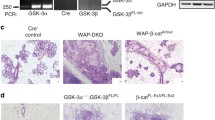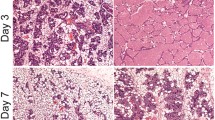Abstract
Cullin 3 (Cul3) has recently been implicated in a multitude of different processes, including the oxidative stress response, autophagy, tumorigenesis, and differentiation. To investigate the role of Cul3 in mammary gland development, we created a mouse model system using Cre-lox targeting where Cul3 is specifically deleted from the mammary gland. Such MMTV-Cre Cul3Flx/Flx mice examined at 2 and 3 months of age show delays and defects in mammary gland development. Mammary ductal trees from Cul3-deficient mammary glands exhibit delayed forward growth through the mammary fat pad, dilation of the ducts, and abnormal morphology of some of the epithelial structures within the gland. Additionally, terminal end buds are larger and less plentiful in MMTV-Cre Cul3Flx/Flx mammary glands, and there is significantly less primary and secondary branching compared to control animals. In contrast, by 6 months of age, the mammary ductal tree has grown to fill the entire mammary fat pad in glands lacking Cul3. However, distorted epithelial structures and dilated ducts persist. MMTV-Cre Cul3Flx/Flx mothers are able to nourish their litters, but the process of involution is slightly delayed in mammary glands lacking Cul3. Therefore, we conclude that while Cul3 is not essential for mammary gland function, Cul3 is required for the mammary gland to proceed normally through development.







Similar content being viewed by others
Availability of data and material
The data that support the findings of this study are available from the corresponding author (JDS), upon request.
Abbreviations
- BrdU:
-
5′-Bromo-2′-deoxyuridine
- Cul:
-
Cullin
- ER:
-
Estrogen receptor
- H&E:
-
Hematoxylin and eosin
- IGF1:
-
Insulin-like growth factor 1
- MATH:
-
Meprin and TRAF homology
- MEF:
-
Mouse embryonic fibroblasts
- MMTV:
-
Mouse mammary tumor virus
- Msx2:
-
Msh homeobox 2
- NRF2:
-
Nuclear factor erythroid 2-related factor 2
- PR:
-
Progesterone receptor
- SPOP:
-
Speckle-type BTB/POZ protein
- TEB:
-
Terminal end bud
- TGF-β:
-
Transforming growth factor beta
References
Anderica-Romero AC, Escobar L, Padilla-Flores T, Pedraza-Chaverri J (2014) Insights in cullin 3/WNK4 and its relationship to blood pressure regulation and electrolyte homeostasis. Cell Signal 26:1166–1172
Bocchinfuso WP, Lindzey JK, Hewitt SC, Clark JA, Myers PH, Cooper R, Korach KS (2000) Induction of mammary gland development in estrogen receptor-alpha knockout mice. Endocrinology 141:2982–2994
Chen HY, Liu CC, Chen RH (2016) Cul3-KLHL20 ubiquitin ligase: physiological functions, stress responses, and disease implications. Cell Div 11:5
Chen Y, Yang Z, Meng M, Zhao Y, Dong N, Yan H, Liu L, Ding M, Peng HB, Shao F (2009) Cullin mediates degradation of RhoA through evolutionarily conserved BTB adaptors to control actin cytoskeleton structure and cell movement. Mol Cell 35:841–855
Cheng J, Guo J, Wang Z, North BJ, Tao K, Dai X, Wei W (2018) Functional analysis of Cullin 3 E3 ligases in tumorigenesis. Biochim Biophys Acta Rev Cancer 1869:11–28
Cui Y, Riedlinger G, Miyoshi K, Tang W, Li C, Deng CX, Robinson GW, Hennighausen L (2004) Inactivation of Stat5 in mouse mammary epithelium during pregnancy reveals distinct functions in cell proliferation, survival, and differentiation. Mol Cell Biol 24:8037–8047
Cullinan SB, Gordan JD, Jin J, Harper JW, Diehl JA (2004) The Keap1-BTB protein is an adaptor that bridges Nrf2 to a Cul3-based E3 ligase: oxidative stress sensing by a Cul3-Keap1 ligase. Mol Cell Biol 24:8477–8486
Curtis Hewitt S, Couse JF, Korach KS (2000) Estrogen receptor transcription and transactivation: Estrogen receptor knockout mice: what their phenotypes reveal about mechanisms of estrogen action. Breast Cancer Res 2:345–352
da Silva Montenegro EM, Costa CS, Campos G, Scliar M, de Almeida TF, Zachi EC, Silva IMW, Chan AJS, Zarrei M, Lourenco NCV, Yamamoto GL, Scherer S, Passos-Bueno MR (2019) Meta-analyses support previous and novel autism candidate genes: outcomes of an unexplored Brazilian cohort. Autism Res
Dubiel W, Dubiel D, Wolf DA, Naumann M (2018) Cullin 3-based ubiquitin ligases as master regulators of mammalian cell differentiation. Trends Biochem Sci 43:95–107
Feng Y, Manka D, Wagner KU, Khan SA (2007) Estrogen receptor-alpha expression in the mammary epithelium is required for ductal and alveolar morphogenesis in mice. Proc Natl Acad Sci USA 104:14718–14723
Frech MS, Halama ED, Tilli MT, Singh B, Gunther EJ, Chodosh LA, Flaws JA, Furth PA (2005) Deregulated estrogen receptor alpha expression in mammary epithelial cells of transgenic mice results in the development of ductal carcinoma in situ. Can Res 65:681–685
Frendo-Cumbo S, Jaldin-Fincati JR, Coyaud E, Laurent EMN, Townsend LK, Tan JMJ, Xavier RJ, Pillon NJ, Raught B, Wright DC, Brumell JH, Klip A (2019) Deficiency of the autophagy gene ATG16L1 induces insulin resistance through KLHL9/KLHL13/CUL3-mediated IRS1 degradation. J Biol Chem 294:16172–16185
Gao K, Jin X, Tang Y, Ma J, Peng J, Yu L, Zhang P, Wang C (2015) Tumor suppressor SPOP mediates the proteasomal degradation of progesterone receptors (PRs) in breast cancer cells. Am J Cancer Res 5:3210–3220
Haslam SZ (1988) Cell to cell interactions and normal mammary gland function. J Dairy Sci 71:2843–2854
Hens JR, Wysolmerski JJ (2005) Key stages of mammary gland development: molecular mechanisms involved in the formation of the embryonic mammary gland. Breast Cancer Res 7:220–224
Hershko A, Ciechanover A (1998) The ubiquitin system. Annu Rev Biochem 67:425–479
Kim EJ, Kim SH, Jin X, Jin X, Kim H (2017) KCTD2, an adaptor of Cullin3 E3 ubiquitin ligase, suppresses gliomagenesis by destabilizing c-Myc. Cell Death Differ 24:649–659
Kossatz U, Breuhahn K, Wolf B, Hardtke-Wolenski M, Wilkens L, Steinemann D, Singer S, Brass F, Kubicka S, Schlegelberger B, Schirmacher P, Manns MP, Singer JD, Malek NP (2010) The cyclin E regulator cullin 3 prevents mouse hepatic progenitor cells from becoming tumor-initiating cells. J Clin Investig 120:3820–3833
Kwon JE, La M, Oh KH, Oh YM, Kim GR, Seol JH, Baek SH, Chiba T, Tanaka K, Bang OS, Joe CO, Chung CH (2006) BTB domain-containing speckle-type POZ protein (SPOP) serves as an adaptor of Daxx for ubiquitination by Cul3-based ubiquitin ligase. J Biol Chem 281:12664–12672
Li G, Ci W, Karmakar S, Chen K, Dhar R, Fan Z, Guo Z, Zhang J, Ke Y, Wang L, Zhuang M, Hu S, Li X, Zhou L, Li X, Calabrese MF, Watson ER, Prasad SM, Rinker-Schaeffer C, Eggener SE, Stricker T, Tian Y, Schulman BA, Liu J, White KP (2014) SPOP promotes tumorigenesis by acting as a key regulatory hub in kidney cancer. Cancer Cell 25:455–468
Li L, Zhang W, Liu Y, Liu X, Cai L, Kang J, Zhang Y, Chen W, Dong C, Zhang Y (2020) The CRL3 BTBD9 E3 ubiquitin ligase complex targets TNFAIP1 for degradation to suppress cancer cell migration. Signal Transduct Target Ther 5:1–9
Lu P, Ewald AJ, Martin GR, Werb Z (2008) Genetic mosaic analysis reveals FGF receptor 2 function in terminal end buds during mammary gland branching morphogenesis. Dev Biol 321:77–87
Lyons WR (1958) Hormonal synergism in mammary growth. Proc R Soc Lond B Biol Sci 149:303–325
Macias H, Hinck L (2012) Mammary gland development. Wiley Interdiscip Rev Dev Biol 1:533–557
McEvoy JD, Kossatz U, Malek N, Singer JD (2007) Constitutive turnover of cyclin E by Cul3 maintains quiescence. Mol Cell Biol 27:3651–3666
Minella AC, Loeb KR, Knecht A, Welcker M, Varnum-Finney BJ, Bernstein ID, Roberts JM, Clurman BE (2008) Cyclin E phosphorylation regulates cell proliferation in hematopoietic and epithelial lineages in vivo. Genes Dev 22:1677–1689
Morandell J, Schwarz LA, Basilico B, Tasciyan S, Dimchev G, Nicolas A, Sommer C, Kreuzinger C, Dotter CP, Knaus LS (2020) Cul3 regulates cytoskeleton protein homeostasis and cell migration during a critical window of brain development. NEURON-D-20–00158
Morreale FE, Walden H (2016) Types of ubiquitin ligases. Cell 165:248-248.e241
Ou CY, Lin YF, Chen YJ, Chien CT (2002) Distinct protein degradation mechanisms mediated by Cul1 and Cul3 controlling Ci stability in Drosophila eye development. Genes Dev 16:2403–2414
Pierce DF Jr, Johnson MD, Matsui Y, Robinson SD, Gold LI, Purchio AF, Daniel CW, Hogan BL, Moses HL (1993) Inhibition of mammary duct development but not alveolar outgrowth during pregnancy in transgenic mice expressing active TGF-beta 1. Genes Dev 7:2308–2317
Robinson GW, Hennighausen L (2011) MMTV-Cre transgenes can adversely affect lactation: considerations for conditional gene deletion in mammary tissue. Anal Biochem 412:92–95
Satoh K, Ginsburg E, Vonderhaar BK (2004) Msx-1 and Msx-2 in mammary gland development. J Mammary Gland Biol Neoplasia 9:195–205
Silberstein GB, Daniel CW (1982) Glycosaminoglycans in the basal lamina and extracellular matrix of the developing mouse mammary duct. Dev Biol 90:215–222
Singer JD, Gurian-West M, Clurman B, Roberts JM (1999) Cullin-3 targets cyclin E for ubiquitination and controls S phase in mammalian cells. Genes Dev 13:2375–2387
Sternlicht MD (2006) Key stages in mammary gland development: the cues that regulate ductal branching morphogenesis. Breast Cancer Res 8:201
Strange R, Li F, Saurer S, Burkhardt A, Friis RR (1992) Apoptotic cell death and tissue remodelling during mouse mammary gland involution. Development (Cambridge, England) 115:49–58
Sumara I, Quadroni M, Frei C, Olma MH, Sumara G, Ricci R, Peter M (2007) A cul3-based e3 ligase removes aurora B from mitotic chromosomes, regulating mitotic progression and completion of cytokinesis in human cells. Dev Cell 12:887–900
Uruno A, Furusawa Y, Yagishita Y, Fukutomi T, Muramatsu H, Negishi T, Sugawara A, Kensler TW, Yamamoto M (2013) The Keap1-Nrf2 system prevents onset of diabetes mellitus. Mol Cell Biol 33:2996–3010
Wagner KU, McAllister K, Ward T, Davis B, Wiseman R, Hennighausen L (2001) Spatial and temporal expression of the Cre gene under the control of the MMTV-LTR in different lines of transgenic mice. Transgenic Res 10:545–553
Wang S, Counterman LJ, Haslam SZ (1990) Progesterone action in normal mouse mammary gland. Endocrinology 127:2183–2189
Williams JM, Daniel CW (1983) Mammary ductal elongation: differentiation of myoepithelium and basal lamina during branching morphogenesis. Dev Biol 97:274–290
Xu G, Mo L, Wu C, Shen X, Dong H, Yu L, Pan P, Pan K (2019) The miR-15a-5p-XIST-CUL3 regulatory axis is important for sepsis-induced acute kidney injury. Ren Fail 41:955–966
Yaghjyan L, Colditz GA (2011) Estrogens in the breast tissue: a systematic review. Cancer Causes Control 22:529–540
Zhang P, Gao K, Jin X, Ma J, Peng J, Wumaier R, Tang Y, Zhang Y, An J, Yan Q, Dong Y, Huang H, Yu L, Wang C (2015a) Endometrial cancer-associated mutants of SPOP are defective in regulating estrogen receptor-alpha protein turnover. Cell Death Dis 6:e1687
Zhang Q, Yu S, Tan Y, Fu J-J (2015b) New insights into the function of Cullin 3 in trophoblast invasion and migration.
Funding
Research was supported by grants from National Institutes of Health (US)-Grant number RO1GM082940 to Jeffrey D. Singer and from Susan G. Komen-Award number BCTR0503636 to Jeffrey D. Singer.
Author information
Authors and Affiliations
Contributions
JDS conceived the work. CMC collected and analyzed the data. CMC wrote the manuscript, and JDS provided critical revision of the article. Both authors reviewed the final manuscript.
Corresponding author
Ethics declarations
Ethics approval
All procedures performed in studies involving animals were in accordance with the ethical standards of the institution at which the studies were conducted.
Consent for publication
The authors affirm that this article has not been previously published elsewhere, and the manuscript is not under consideration for publication in another journal. Both authors consent to the publication of the manuscript should the article be accepted.
Conflict of interest
The authors declare that they have no conflicts of interest.
Additional information
Publisher's Note
Springer Nature remains neutral with regard to jurisdictional claims in published maps and institutional affiliations.
Supplementary information
Below is the link to the electronic supplementary material.
Rights and permissions
About this article
Cite this article
Cummings, C.M., Singer, J.D. Cul3 is required for normal development of the mammary gland. Cell Tissue Res 385, 49–63 (2021). https://doi.org/10.1007/s00441-021-03456-1
Received:
Accepted:
Published:
Issue Date:
DOI: https://doi.org/10.1007/s00441-021-03456-1




